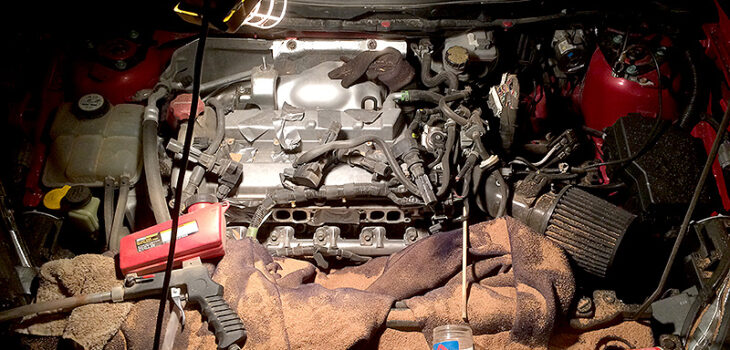
2011 Mazdaspeed3 PCV Valve Replacement and Valve Cleaning
My 2011 Mazdaspeed3 is a very fun, fuel-efficient, powerful and quick car. I get around 35 MPG on the highway, and my average MPG is currently at 29 with highway and city travel combined.
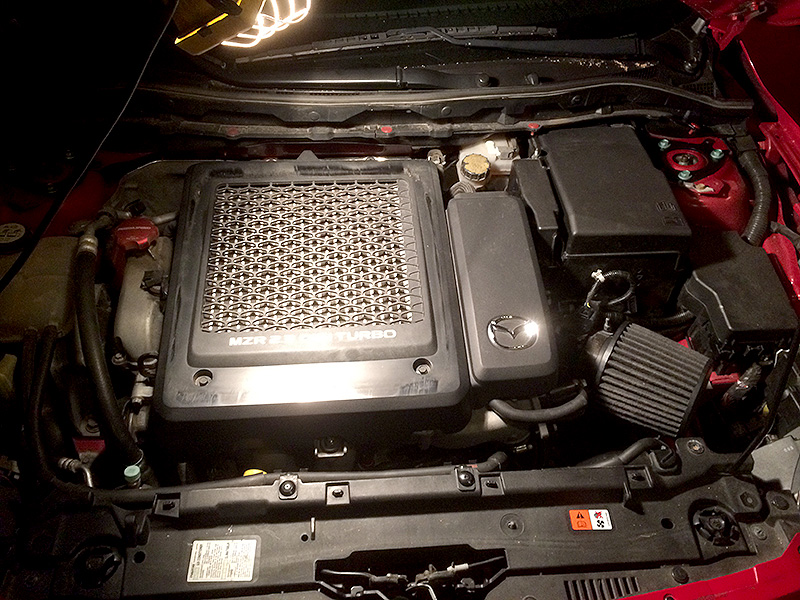
One draw-back to newer turbo direct-injection cars is that they have issues with oil consumption due to PCV valves, oil seals, or with oil leaking into the exhaust due to seals in the turbo leaking oil that is under pressure. A new turbo is over $1,200 for a decent one, and they go higher. I have been loosing about 1 quart of oil every week and a half since December of 2014. I’ve chased down the oil consumption to 2 items: the PCV valve or the turbo. The PCV valve is only about $22, but requires the entire intake system being removed to access (see below). Cost by a repair shop was $300-400 and since I just spent $400 on new rear struts, I thought I’d give this repair a go…myself.
I follow many groups of Mazdaspeed3 and Mazdaspeed6 owners and have all sorts of information on what can be done while the intake is off, and one BIGGIE is cleaning the intake valves. The way these cars are designed and how they run cause a SIGNIFICANT amount of carbon to build on the intake valves of the car’s engine. Being a high-output 4 cylinder engine (286 HP factory), the engine has 2 intake valves per cylinder, and any blockage of the intake reduces performance.
So after weeks of trying to decide if I was able to deal with this level of work on my own, I decided to have a go (click on thumbs below to see larger images)…
^ I began with removing the intercooler cover, intercooler, and the electronics (which took a significant amount of time). No two cars have the same electronics release it seems! This job also started off while it was raining, and my garage is not big enough to get the car inside, so it was pulled up to the door!
^ I then removed the throttle body and began to notice oil around some of the parts. I also removed the remaining bolts from the intake and used a wooden handle to gently pry the intake from the gasket, leaving the engine stripped of many parts, most notably the intake system!
^ I had my first look at my cars inner parts, which revealed very carbon-caked intake valves, a PCV valve (hidden under the intake!) with oil pooled in the lower end, and an EGR valve that was full of both significant carbon deposits as well as oil. :^(
^ I could see that a good bit of oil had varnished the inside of the PCV valve, and the oil separator of the PCV valve was also thick with oil. Also above you can see the top section of the EGR valve is also full of carbon. Further reading suggested that much of the carbon on the intake valves is a result of the EGR system…
^ It may be difficult to see how dirty the intake valves were, but each had significant carbon build-up and oil deposits. Remember, there are 8 intake valves on this 4 cylinder engine…
I ran out of time tearing the engine apart on weekend #1, so the car sat in the driveway until the following weekend.
^ Weekend #2… after significant reading on various websites and forums such as http://www.mazdaspeedforums.org/ I felt I had enough information to do the job myself. After a couple trips to Harbor Freight in Miamisburg, OH I had the tools needed too! The most detailed article on the work I found was here: http://www.mazdaspeedforums.org/forum/f33/how-clean-your-valves-easy-cheap-120211/ and in the page, you can see even better photos of just what I saw on my own car’s valves, and how they looked when done properly. Just note, that my walnut media blasting process was MUCH more messy than the author of that post!
Also shown, I had to remove my front wheel to access the engine’s crank to advance the engine to get the intake valves to close in order to clean them. Otherwise the walnut media all goes into the cylinders and can be very damaging. I also noticed my serpentine belt was cracked, and had to order/replace it too. The Mazdaspeed cars are all unique cars and nearly everything must be special ordered or come from the dealer!
^ The walnut media blasting took much longer than expected. My car has 135,000 miles on it, and many owners have had to do the valve cleaning after just 40k miles, so mine were seasoned carbon valves! The process can be very messy, and takes a good bit of work to blast off the carbon/oil from each valve, but it is worthwhile.
The photo above on right is what the car looked like on my driveway after the last valves were finally clean enough for me. Not perfect, but I was tired of not having a car to drive, and tired of always having to work on it. Still, yet another weekend was past, and I had worked on it Friday, Saturday, and Sunday nights after special ordering gaskets, PCV valve, PCV valve retainer (old one broke), and deciding to get a new intake gasket.
^ After 2 full weekends of working on my car, by the following Wednesday morning, I finally had all the parts and the engine was ready to go back together. However, we were going out of town the following weekend, and I would have to wait another full week to get the car back on the road. Not acceptable!
So after working some overtime on Thursday, I decided I was going to come home and stay up until the car was back together and working! That is just what I did, finally finishing the job around 3:00 am on Friday morning. Started it up, let it idle while I cleaned up the garage, and after 25 minutes took a drive down the road with no issues.
As shown above, I had to completely remove all the cold air intake too, in order to reach the EGR bolts that I dropped about 4 times, and took way too long to keep looking for. Once the rest of the intake was out of the way, that process was quick, and actually helped me get my battery reinstalled where it should be again!
Another unfortunate thing that happened was that I did not install one of the intake bolts that went under the intake and installed upwards. Once I had the other parts in, I could not reach it. That and a retainer key that disappeared into the fender are the only casualties of the job, but both should be able to be added back fairly easily…
^ Added cold air intake back, then battery and electronics, then intercooler…
^ Finally adding the intercooler cover back on and I was DONE and very tired but wired from the work so late into the morning.
Takeaway:
- This car is a HUGE pain to work on, as it seems the designers were on computers, and were not doing any manual assessments.
- But with patience you can do a good job.
- Estimate for replace PCV valve by auto shop:
- ~ $350-400 + tax, cleaning of intake valves: ~$400-??? + tax = $750-900
- My cost (minus new tools):
- $35 (belt), $25 (intake, throttle body, and EGR gaskets), $22 (PCV valve) = $82
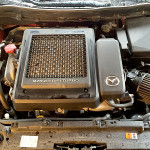
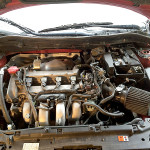
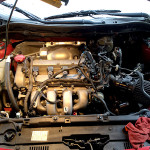
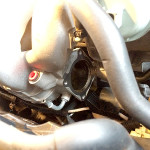
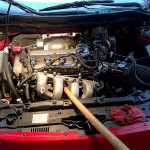
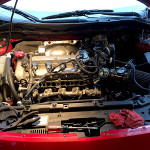
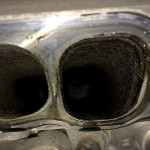
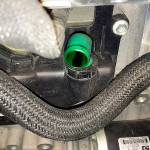
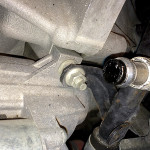
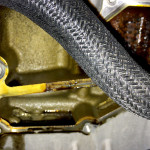

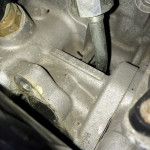
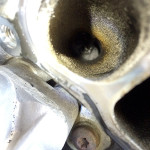
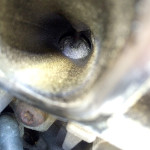
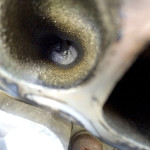
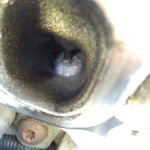
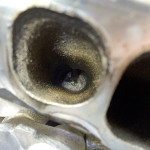
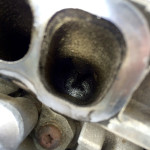
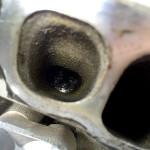
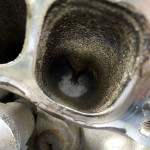
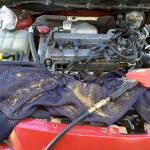
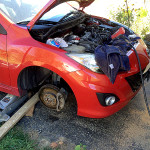
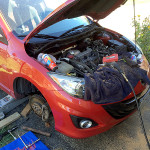
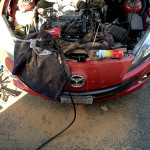
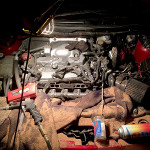
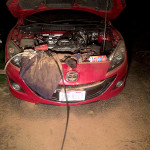
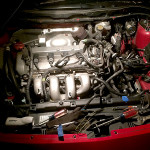
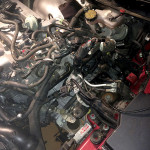
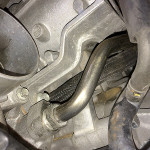
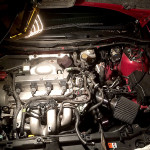
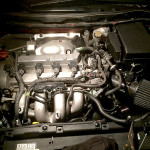
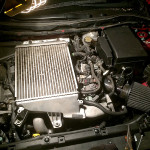
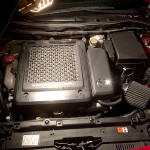
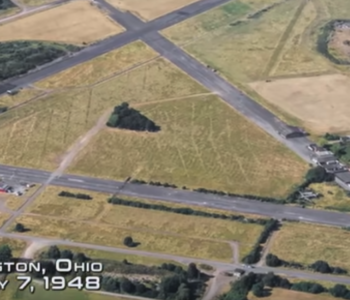
2 COMMENTS
Did that fix or at least improve your oil consumption? My 2008 Speed3 is in the same boat and I will be attempting the pcv surgery soon.
Unfortunately no. I had to have new rings. But as OEM rings were so expensive (as was the work), I got with a local tuner and they put Manley rings, pistons, rods, etc. and built my engine to Stage 3 level for what OEM work was expected to cost. If you are anywhere near Cincinnati, OH I can hook you up with the same guys. – Roger